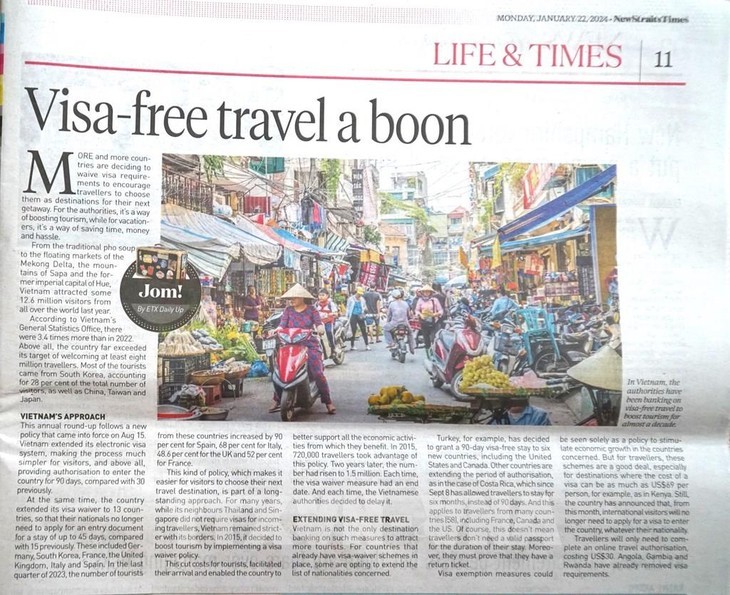Titled “Visa-free travel a boon”, the article highlights the positive impact of Vietnam’s policy of making tourist visas free and expanding the number of beneficiaries. This has resulted in a significant increase in visitor arrivals to Vietnam.
According to the article, an increasing number of countries are choosing to waive visa requirements in order to boost tourism. It is seen as a win-win situation, as it promotes tourism for the authorities and saves time and money for the tourists.
 |
| The article highlights that more and more countries are waiving visa requirements to stimulate tourism demand. Photo: VNA |
The article mentions that Vietnam received 12.6 million visitors from all around the world in 2023, thanks to its attractions such as the traditional pho soup, the floating markets of the Mekong River Delta, the mountains of Sa Pa, and the former imperial capital of Hue.
It is emphasized that Vietnam implemented a visa-free travel policy and expanded the benefits from this policy in order to surpass the expected number of tourists in 2023.
Specifically, Vietnam has simplified entry procedures on the online system and now allows tourists to stay in the country for 90 days, compared to the previous limit of 30 days.
In addition, Vietnam has waived visa entry for 13 countries and extended the maximum stay to 45 days, an increase from the previous 15 days. These countries include Germany, ROK, France, UK, Italy, Spain…
In the last quarter of 2023, there was a significant increase in visitors from Spain (90%), the UK (48.6%), and France (52%).
The article argues that this policy has created favorable conditions for tourists to choose Vietnam as their next destination, aligning with Vietnam’s long-standing approach.
The article concludes that visa exemption is an effective policy to stimulate economic growth for each country. For tourists, this policy serves as an incentive to explore and plan their future vacations.
Last year, Vietnam welcomed 12.6 million visitors from all over the world with attractions like pho and bun cha dishes, the floating markets in the Mekong Delta, mountain towns like Sa Pa and Da Lat, and the ancient imperial capital in Hue. This increase in visitor numbers was driven by Vietnam’s extension of its electronic visa system, which made obtaining a visa much easier and allowed for 90-day tourist visits instead of the previous limit of 30 days.
|
Effective from August 15, 2023, Vietnam’s new visa policy extends the stay duration for 13 countries enjoying unilateral visa exemption from 15 days to 45 days, regardless of passport type and entry purpose. The 13 countries include Germany, France, Italy, Spain, UK, Russia, Japan, ROK, Denmark, Sweden, Norway, Finland, and Belarus. List of border gates that allow foreigners to enter and exit Vietnam using an E-visa: 13 international airports: Noi Bai (Ha Noi), Tan Son Nhat (Ho Chi Minh City), Cam Ranh (Khanh Hoa), Da Nang, Cat Bi (Hai Phong), Can Tho, Phu Quoc (Kien Giang), Phu Bai (Thua Thien Hue), Van Don (Quang Ninh), Tho Xuan (Thanh Hoa), Dong Hoi (Quang Binh), Phu Cat (Binh Dinh), Lien Khuong (Lam Dong). 16 land border gates: Tay Trang (Dien Bien), Mong Cai (Quang Ninh), Huu Nghi (Lang Son), Lao Cai, Na Meo (Thanh Hoa), Nam Can (Nghe An), Cau Treo (Ha Tinh), Cha Lo (Quang Binh), La Lay and Lao Bao (Quang Tri), Bo Y (Kon Tum), Moc Bai and Xa Mat (Tay Ninh), Tinh Bien and Vinh Xuong (An Giang), Ha Tien (Kien Giang). 13 sea border gates: Hon Gai and Cam Pha (Quang Ninh), Hai Phong, Nghi Son (Thanh Hoa), Vung Ang (Ha Tinh), Chan May (Thua Thien Hue), Da Nang, Nha Trang (Khanh Hoa), Quy Nhon (Binh Dinh), Dung Quat (Quang Ngai), Vung Tau (Ba Ria – Vung Tau), Ho Chi Minh City, Duong Dong (Kien Giang). |








